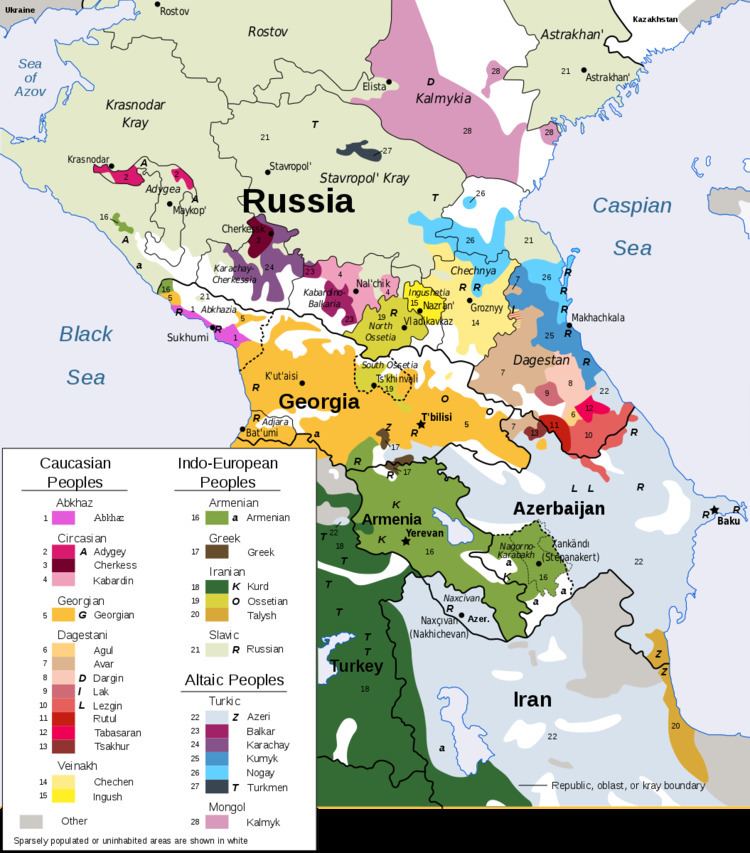Pronunciation [lezɡi tʃʼal] Native speakers 655,000 (2016) | Ethnicity Lezgins | |
 | ||
Language family Northeast CaucasianLezgicSamurEastern SamurLezgi–Aghul–TabasaranLezgian | ||
Lezgian /ˈlɛzɡiən/, also called Lezgi or Lezgin, is a language that belongs to the Lezgic languages. It is spoken by the Lezgins, who live in southern Dagestan and northern Azerbaijan. Lezgian is a literary language and an official language of Dagestan. It is classified as "vulnerable" by UNESCO's Atlas of the World's Languages in Danger.
Contents
Geographic distribution
In 2002, Lezgian was spoken by about 397,000 people in Russia, mainly Southern Dagestan, and in 1999 by 178,400 people in mainly the Qusar, Quba, Qabala, Oghuz, Ismailli and Khachmaz (Xaçmaz) provinces of northeastern Azerbaijan. Lezgian is also spoken in Kazakhstan, Kyrgyzstan, Turkey, Turkmenistan, Ukraine, and Uzbekistan by immigrants from Azerbaijan and Daghestan.
There are also small populations in the Balikesir and Yalova regions in Turkey. The Lezgian people are concentrated mainly in Kirne (Ortaca) village of the Balikesir region.
The total number of speakers is about 800,000.
Related languages
There are nine languages in the Lezgic language family, namely: Lezgian, Tabasaran, Rutul, Aghul, Tsakhur, Budukh, Kryts, Udi and Archi. These languages have the same names as their ethnic groups.
Some of its dialects are considered very different from the standard form, including the Quba dialect spoken in Azerbaijan.
Vowels
Consonants
There are 54 consonants in Lezgian. Characters to the right are the letters of the Lezgian Cyrillic Alphabet. Note that aspiration is not normally indicated in the orthography, despite the fact that it is phonemic.
Alphabets
Lezgian has been written in several different alphabets over the course of its history. These alphabets have been based on three scripts: Arabic (before 1928), Latin (1928–38), and Cyrillic (1938–present).
The Lezgian Cyrillic alphabet is as follows:
The Latin alphabet was as follows:
Grammar
Lezgian is unusual for a Northeast Caucasian language in not having noun classes (also called "grammatical gender"). Standard Lezgian grammar features 18 grammatical cases, produced by agglutinating suffixes, of which 12 are still used in spoken conversation.
Cases
The four grammatical cases are:
Declension
There are two types of declensions.
Numbers
The numbers of Lezgian are:
Nouns following a number are always in the singular. Numbers precede the noun. "Сад" and "кьвед" lose their final "-д" before a noun.
Lezgian numerals work in a similar fashion to the French ones, and are based on the vigesimal system in which "20", not "10", is the base number. "Twenty" in Lezgian is "къад", and higher numbers are formed by adding the suffix -ни to the word (which becomes "къанни" - the same change occurs in пудкъад and кьудкъад) and putting the remaining number afterwards. This way 24 for instance is къанни кьуд ("20 and 4"), and 37 is къанни цӏерид ("20 and 17"). Numbers over 40 are formed similarly (яхцӏур becomes яхцӏурни). 60 and 80 are treated likewise. For numbers over 100 just put a number of hundreds, then (if need be) the word with a suffix, then the remaining number. 659 is thus ругуд вишни яхцӏурни цӏекӏуьд. The same procedure follows for 1000. 1989 is агьзурни кӏуьд вишни кьудкъанни кӏуьд in Lezgi.
